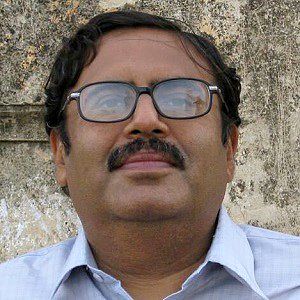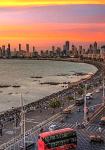'Around April 1-2, both states had similar number of cases, around 300.'
'The number of deaths in Kerala were 2 and in Maharashtra around 10. But the two graphs have diverged after that.'

Dr Abhay Shukla is a public health physician and has vast experience in working on health issues at the grassroots in western India. He is the co-covenor of the Jan Swastha Abhiyan or People's Health Movement.
Dr Shukla, below, has co-edited and authored several books: Review of Health Care in India, Report on Health Inequities in Maharashtra, Health System in India -- Crisis and Alternatives and The Rights Approach to Health and Health Care.
"Till a few days back in Maharashtra, we were thinking that only a few people are infected when actually many more were," Dr Shukla tells Rediff.com's Archana Masih, discussing the reasons behind the rising cases in Maharashtra and how Kerala contained the epidemic. The first of a two-part interview:
Maharashtra is the worst COVID-19 affected state. As a public health practitioner, what should be done and what are the critical recommendations to deal with the surging cases?
There are some things that are easily do-able and there others that are not, yet they can be done if there is a political will and imagination.
If you compare the current situation in Maharashtra and Kerala. Around April 1-2, both states had similar number of cases, around 300. The number of deaths in Kerala were 2 and in Maharashtra around 10. But the two graphs have diverged after that.
Kerela was the first state in India with COVID-19 cases when they had a student returning from Wuhan with the infection.
Kerala is a high-risk state because it has a large number of international travellers. It also has a lot of domestic travellers because its natives work in various other states in the country and return to the state.
Despite that, Kerala was able to contain the epidemic while Maharashtra couldn't and cases spiralled.
The number of deaths in Maharashtra is now 149 and Kerala has held it at 2 (As on April 9).
Kerala's entire public health structure is dedicated to this and they are informing people on a daily basis.
Maharashtra has a greater per capita income than Kerala and Mumbai is the financial capital of the country. Despite that, why have we landed in such a situation.
Why are the COVID-19 cases mounting in Maharashtra? Its fatality rate is double that of the national average.
There are four arms to dealing with COVID--19. Maharashtra is making reasonable efforts no doubt, but they are not enough, which is why, especially in Mumbai, the situation has spiralled.
A lockdown is no substitute for careful testing, tracing, tracking, treatment and isolation of each and every person who is a contact, or a contact of a suspect.
This is what Kerala did. Kerala's testing rates are much higher than Maharashtra.
Just by locking down the whole state of Maharashtra with 12 crore people will not be sufficient. Moreover, it is not working very well in rural areas.
South Korea contained this epidemic without a lockdown. It was the second country after China where the outbreak happened. They controlled it very effectively and now we hardly hear about COVID-19 cases in South Korea.
One must understand that a lockdown is a very crude and blanket measure. It may be required for a short period of time, but it is not a substitute for individualised very large-scale testing, which is what South Korea or Kerala did or what Maharashtra is trying now.
Wide-scale testing gives you the number of people actually infected. Till a few days back in Maharashtra, we were thinking that only a few people are infected when actually many more were.
Deaths on a particular day show what the extent of the epidemic was two weeks back.
We did not pick up a large number of cases because of inadequate testing at that time and those people were roaming around the community.
They were visiting hospitals because they were not infected at that time. When they infected more people and deaths started being recorded, we realised that there were many cases.
First of all, testing has to be expanded significantly. It is most necessary.
We have passed the stage where we could have put the cat back in the bag.
Once travellers are the contacts it is easy to control, but once it becomes a community-based spread it is more difficult to control. Still with some focal containment it can be tackled.
Containment areas have been earmarked in Mumbai and Pune. It is very important, but still the bedrock remains large-scale testing, tracing of contacts, and isolation through home quarantine.
In Kerala, some 10,000 were in home quarantine which means you stay at home and within the home also you remain in your room and people in the family take care of you without getting exposed to you.
You stay there for 14 days until you are fine. If you develop symptoms you are shifted directly to a hospital.
Home quarantine has to be done very strictly on all the contacts.

In Mumbai, as many as 85 hospital staff have been infected and at least four private hospitals are not admitting new patients.
At one hospital, nurses were infected because they were dealing with a patient who tested positive. Those nurses stay in the same room as other nurses and 50 other healthcare workers came down with the infection.
There was gross negligence in providing PPE and following the isolation protocol. This is an Italy-kind of situation where a hospital became the epi-centre of the infection. Instead of controlling centres, they become amplifying centres.
A range of measures have to be coordinated, it is not only about enforcing a lockdown and expecting that the epidemic will be controlled.
It has to be done in a nuanced, strategic and integrated manner.
We have not been able to do testing and contact tracing on the required scale, we have not been able to isolate contacts effectively, not provided adequate PPE to nurses and other staff in contrast to Kerala.
Kerala has a graded strategy for providing PPE. Not everybody needs the head to toe kind of spacesuit which is required in the COVID-19 ICU where there is very high risk of infection.
In OPDs and wards, different grades of PPE is provided, Kerala has put that on its Web site and is following it.
Who is responsible for the 50 workers being infected at a private hospital in Mumbai?
Has any official said anything about the management of that hospital and these are supposedly big and private hospitals in Mumbai.
PPE are scarce and must be in short supply in rural areas. How must that be making rural healthcare workers vulnerable to infection?
In the public health system like in rural PHCs (public health centres) there is a shortage of PPE which must be exposing doctors, healthcare workers and ASHAs who have been asked to do various activities. They all need to be given all these as priority.
It cannot be treated as business like usual. It is a war-like situation.
Do we send our soldiers to fight a war without bullets? If we can give guns and bullets to our soldiers, why not masks and PPE to our doctors and nurses?
Private sector and industries should be roped in to make masks and other necessary equipment as urgent priority.
Private companies have been asked to make PPE, ventilators, masks, gloves etc. Do you think we started doing this late? Should we have pre-empted the situation?
1. People need to be given accurate, updated, honest and comprehensive information about what is exactly going on.
The Kerala CM addresses the state every evening at 6 pm. He debunks misinformation on WhatsApp etc and gives the exact number of cases, what the state government is doing and how people need to co-operate by doing a b c d.
It is not only about people sitting at home after a lockdown. That is not enough. They have mobilised tens of thousands of volunteers.
Every panchayat has been asked to mobilise 100 volunteers and entrusted the job of providing food to all those in home quarantine.
You can only expect people to remain in quarantine if you provide them daily needs, otherwise they will come out looking for it.
Public organisation and mobilisation is critical. Sitting at home and wearing masks while coming out is not sufficient. We need much more effective public communication and mobilisation system.
The Maharashtra chief minister has been addressing the people of the state regularly online.
He should do an online press conference if possible too. Maybe he could ask the media to send him some questions before hand and he can answer some questions from that when he addresses the state. There has to be very pro-active communication.












 © 2025
© 2025